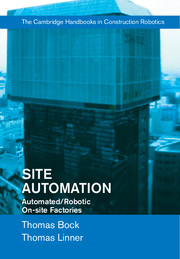Book contents
- Frontmatter
- Contents
- Acknowledgements
- Glossary
- 1 Integrated Automated/Robotic On-site Factories
- 2 Analysis and Categorization: Construction pages 8 to 144
- 2 Analysis and Categorization: Construction pages 145 to 256
- 3 Analysis and Categorization: Deconstruction
- 4 Conclusion: Discrepancy between Technical Capability and Efficiency
- References
- Index
1 - Integrated Automated/Robotic On-site Factories
Published online by Cambridge University Press: 05 April 2016
- Frontmatter
- Contents
- Acknowledgements
- Glossary
- 1 Integrated Automated/Robotic On-site Factories
- 2 Analysis and Categorization: Construction pages 8 to 144
- 2 Analysis and Categorization: Construction pages 145 to 256
- 3 Analysis and Categorization: Deconstruction
- 4 Conclusion: Discrepancy between Technical Capability and Efficiency
- References
- Index
Summary
In this volume all worldwide conducted approaches following an on-site factory approach were analysed. Thirty different systems were identified, resulting in an application of automated/robotic on-site factory technology about 60 times. The analysis was for each system split into a more technical part and a part that focuses on indicators related to productivity, efficiency, and economic performance. All systems were analysed systematically and based on the same framework. On the basis of the analysis, a categorization system was developed and 13 categories were set up (10 categories for construction and 3 for deconstruction).
As discussed in Volume 3, one of the main ideas for setting up automated on-site factories was to integrate stand-alone or single-task construction robot (STCR) technology in structured on-site environments into networked machine systems and thus to improve through interlinked machine activities the organization, integration, and material flow on the construction site (apart from the possibility to off-site manufacture components discussed in Volume 2). The analysis clarifies for which building typologies automated/robotic on-site factories are an applicable approach and how and to which extent each of those systems is technologically flexible to be able to manufacture a variety of different buildings (products) on the basis of industrialized, automated, and flow-line–like stable factory processes on the construction site. Furthermore, it should be clarified whether, in contrast to the STCR approach (see Volume 3), the approach of setting up automated/robotic on-site factories is capable of achieving a performance multiplication (e.g., by 10-fold as in tunneling or automotive industry; for further details see Volume 1), which usually accompanies the switch from arts and crafts–based manufacturing to machine-based manufacturing.
In this volume, first, frameworks for the technical analysis and the efficiency analysis classified into various fields, analysis subjects, and indicators are set up. Second, 30 systems are analysed according to the technical analysis framework and classified into two main categories (construction: 24, deconstruction: 6) and a total of 13 subcategories. Ten of those systems are also analysed with regard to analysis subjects and indicators that determine or influence productivity, efficiency, and overall economic performance. An Analysis and Categorization Matrix (see Figure 2.35) gives an overview over systems, categories, analysed analysis subjects and indicators, and available data. Finally, the findings are summarized (see Chapter 4). The analysis claims to include all approaches to automated/robotic on-site factories that were conducted so far.
- Type
- Chapter
- Information
- Site AutomationAutomated/Robotic On-Site Factories, pp. 1 - 7Publisher: Cambridge University PressPrint publication year: 2016
- 2
- Cited by



